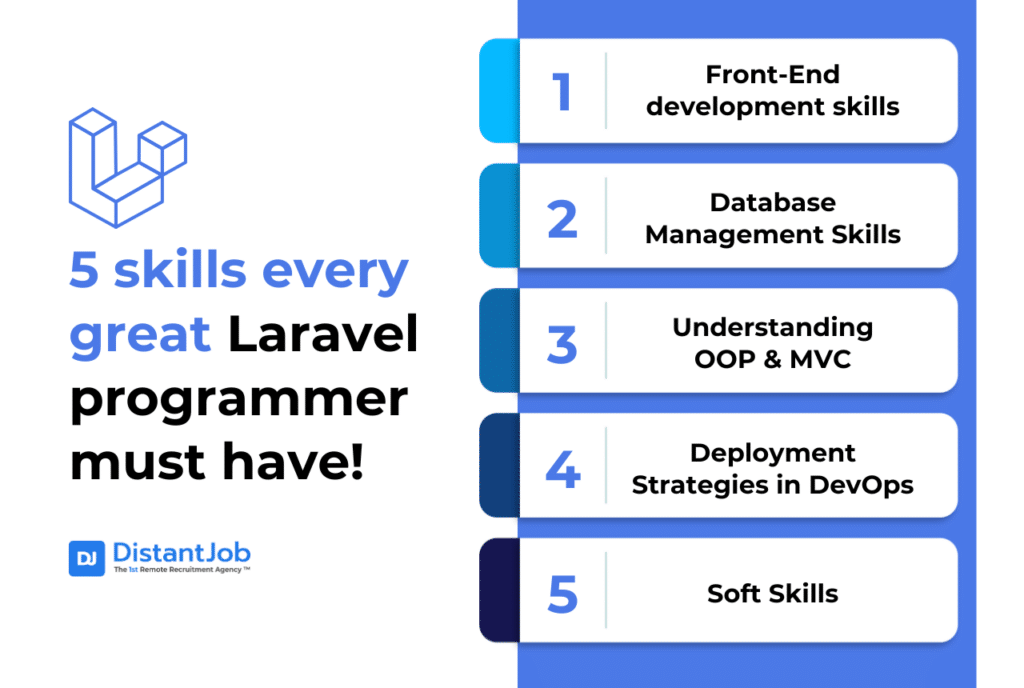When hiring a Laravel developer, knowing which skills to prioritize is crucial to finding the right fit for your team. While expertise in the Laravel framework is non-negotiable, there are other key skills to look for that will ensure you’re onboarding a top-notch coder. A skilled Laravel developer should also be proficient in modern PHP, can build routes and database models with Eloquent, secure apps with Laravel’s built-in auth, write tests, make sites fast, and deploy smoothly with tools like Docker or Forge.
However, technical expertise alone isn’t enough. A true Laravel expert should excel in collaboration and communication, possess soft skills that facilitate teamwork, and have a working knowledge of project management methodologies. This combination of technical and interpersonal skills is essential for a Laravel developer to thrive in any new team environment and deliver results efficiently.
According to a recent Adeva survey, Laravel’s ecosystem is 96% male-dominated. 67% of Laravel developers work on products serving less than 10,000 users, which implies that the majority of them work in projects of a smaller scale and smaller companies. What doesn’t mean that Laravel has no scalability: 44% of Laravel products have over 1 million users, built by companies with less than 50 employees. Finally, 82% of developers use Laravel exclusively on the backend.
Now, let’s get down to business. If you have upcoming interviews for candidates looking to fill the Laravel job opening or if you are a Laravel developer yourself, make sure these skills are at the table.
These are the five skills every great Laravel programmer has:
- Front-End development
- Database Management
- Understanding OOP & MVC
- Deployment Strategies in DevOps
- Soft Skills

1. Front-End Technologies
Talented Laravel developers should have a strong knowledge of front-end technologies and know how they interact with Laravel. It’s not just about writing code; it’s about making architectural decisions, optimizing for scale, and guiding teams to build systems. A good Laravel developer chooses the right front-end approach for a given project and ensures its successful implementation.
They need to evaluate, for example, Blade vs. Livewire vs. Inertia vs. a separate front-end, and even hybrid approaches. If the team has JavaScript expertise, adopting Inertia with React/Vue could be advantageous to leverage those skills. On the other hand, in situations when SEO or maintainability is key, the developer might choose a Blade/Livewire approach to keep things server-rendered (since content rendered on the server is immediately available to search engines, aiding SEO). Understanding these nuances is a part of a Laravel developer’s skills.
Take notice that we’re not talking about how many frameworks the developer knows or if he or she has Advanced Limewire or Inertia skills. We’re talking about how to use these skills in the front-end in diverse projects and situations.
In other words, instead of marking a checklist, focus on how a Laravel developer approaches a project.
2. Database Management Skills
Laravel developers are experts in managing database systems. They can organize all the data from a company’s website, making it easier for end-users to quickly and effectively share the data across the organization. Some of the most popular database management systems are Oracle 12c, MySQL, Microsoft SQL, PostgreSQL, and MongoDB. They are also familiar with Laravel’s Eloquent ORM, writing efficient database queries and complex SQL queries. Plus, optimizing database performance is also one of the Laravel developer skills.
Don’t forget to assess skills associated with Laravel itself:
- Blade Templating Engine: The template engine built into the Laravel framework. It creates dynamic and reusable views efficiently.
- Laravel’s Eloquent ORM: Simplifies interactions with the database, defining models and establishing relationships.
Finally, every Laravel expert should have a deep knowledge of version control systems, such as Git. Git is a must for collaboration with other developers and to keep the code’s integrity. A Laravel developer knows about branching, resolving conflicts, and merging.
3. Object-Oriented Programming
Lavarel is based on MVC architecture, making it easy to start projects with.
Laravel, like most other frameworks, is built on top of object-oriented philosophy. As such, developers must understand OOP and its concepts such as classes, objects, methods, traits, etc. They also have to know how to create models, controllers, and views, and understand the flow of data between them. Don’t forget the routing and middleware.
4. Deployment Strategies in DevOps
I hope you don’t take me into the “True Scotsman” fallacy at this point, but a good Laravel developer knows how many ways to deploy in a DevOps environment. Deployment is constant, and the user expects those CI and CD pipelines to keep flowing even if he has no idea what they are. In other words, these Laravel developer skills involve workflow automation to deliver web apps quickly and safely.
Here are some strategies a Laravel programmer should be familiar with:
A/B test
Loved by marketeers and project managers, and hated by most developers I know, it consists of testing versions of a variable (a website, a feature, etc.) and seeing what the user enjoys more. If done right, it adds much value to the project; done wrong, it makes the devs overwork for nothing. A Laravel developer knows when it should be used.
Rolling Deployment
Focuses on releasing gradually and in control. The team creates many instances and/or servers, and they monitor how the software behaves in different conditions. If you are a pro gamer, maybe you already heard about the beta server or the game server of your favorite game. That is how devs make their magic, minimizing bugs and glitches, testing features and so on.
Canary Release
Maybe you don’t know, but in the 19th Century, miners brought canaries to detect poison gas in their mines. A Canary Release is similar: the devs give some extra new features to a few selected users (canaries), so they can receive feedback from their inputs. Gladly, no poison gas is involved.
5. Soft Skills
Being a good Laravel developer only goes so far when you’re working with others. You’ll want someone highly motivated, communicates clearly, and works well with the rest of the team so everyone can be more productive and happy while working.
Soft skills should be highly valued and tested in interviews. You’ll want someone in your team who, besides being an excellent Laravel developer, also has the skills below:
- Knows how to work in a group, listens to others’ ideas, and provides their own.
- Accepts criticism and is always trying to be better
- Provides creative solutions
- Has great communication abilities
- Distributes their time efficiently and delivers tasks on time
- Is self-reliant
Here are some average salaries of Laravel developers in different U.S. cities, according to ZipRecruiter:
| City | Salary per year | Salary per month | Salary per week | Salary per hour |
| Nome, AK | $159,279 | $13,273 | $3,063 | $76.58 |
| Cupertino, CA | $158,412 | $13,201 | $3,046 | $76.16 |
| Berkeley, CA | $157,218 | $13,101 | $3,023 | $75.59 |
| Redwood City, CA | $157,207 | $13,100 | $3,023 | $75.58 |
| Atherton, CA | $155,619 | $12,968 | $2,992 | $74.82 |
| Sitka, AK | $154,681 | $12,890 | $2,974 | $74.37 |
| Wyoming, WY | $153,133 | $12,761 | $2,944 | $73.62 |
| Santa Clara, CA | $151,637 | $12,636 | $2,916 | $72.90 |
| San Francisco, CA | $151,277 | $12,606 | $2,909 | $72.73 |
| Sunnyvale, CA | $151,157 | $12,596 | $2,906 | $72.67 |
How to Test Your Laravel Candidate Skills?
Finding candidates is only part of the process. Finding a winning candidate takes some skill and a very thorough interviewing process. You’ll want to evaluate both their technical and soft skills.
These interviews can be virtual or physical, depending on what you find suitable and convenient, and may take different approaches depending on what you’re trying to evaluate. The two most common types of interviews are:
- Technical interviews: These are your typical interviews, where you prepare a battery of technical questions pertaining to the nature of the job and use them to assess the candidate. As the name implies, these are better suited to evaluating the overall technical knowledge of candidates but say little in terms of how they work as part of a team. You’ll want to use this type of interview to test your candidates on their Laravel expertise, for example.
- Coding challenges: Coding challenges, such as pair-programming interviews, are better suited to assessing a candidate’s soft skills. While they can also be used to assess technical skills, they are tailored to test creativity and problem-solving, all while in an environment that resembles the candidate’s day-to-day job. You’ll want to give your candidates a custom test that closely resembles the types of challenges they will face regularly.
Best Questions To Ask in a Laravel Interview
Here is a sample of questions to ask your candidate for Laravel development, with increasing difficulty:
1. What Artisan Commands do you know?
Artisan is a command-line interface that Laravel comes packaged with. It provides several commands that help you automate certain tasks when building your Laravel applications. You can also create new commands to help you with the specificity of your projects. Examples of default commands provided include:ith the specificity of your projects. Examples of default commands provided include:
| Command | What It Does |
| make:controller [ControllerName] | Creates a controller to manage user inputs |
| make:model [ModelName] | Creates an Eloquent model to interact with database records |
| ui bootstrap | Creates a front-end scaffolding for Bootstrap |
| ui vue | Creates a front-end scaffolding for Vue |
| ui react | Creates a front-end scaffolding for React |
| make:migration | Creates a migration |
| migrate | Applies all pending migrations to update your database schema |
| route:list | Lists all routes defined by your application |
| serve | Starts the Laravel development server and provides the URL to the running Laravel application |
| down | Takes a Laravel application down for maintenance |
| up | Takes a Laravel application down for maintenance and makes it go live |
| list | Lists all available commands |
| view:clear | Clear all cached view files, solving issues with outdated templates |
2. How Do You Generate Events And Listeners?
There are two main ways to generate Laravel events and listeners. One is doing so by hand by defining them in the App\Providers\EventServiceProvider file:
use App\Events\BookRead;
use App\Listeners\SendReadNotification;
protected $listen = [
BookRead::class => [
SendReadNotification::class,
],
];But this requires the developer to define all of these classes, which can become cumbersome as the application grows. A more convenient method is available by using Artisan. We’ll still need to define the event and listener as paths in the App\Providers\EventServiceProvider file:
protected $listen = [
'App\Events\BookWasPurchased' => [
'App\Listeners\EmailPurchaseConfirmation',
],
];
And then you can use Artisan to generate all the needed definitions and classes for you:
php artisan event:generateThis will run through all the $listen list and generate all events and listeners that do not yet exist.
A third method using Artisan is available, which allows you to create events and listeners with a specific command:
php artisan make:event BookRead
php artisan make:listener SendReadNotification--event=BookRead3. What are Queues and Job Workers In Laravel?
Queues are a list of jobs that Laravel runs (assuming you have free workers) in the background while the rest of the application runs unimpeded. They are useful to process complex or long tasks that would take too long to perform during a typical web request. By running these intense tasks in the background, your application can remain responsive to your users while still performing these taxing jobs.
Job workers are entities that pick up jobs from a queue and execute them, one at a time. You can have several workers running at once, and jobs will be distributed to them as they are queued. If you have 5 workers, you can handle 5 jobs at a time. Increasing the number may consume RAM, freeze the server, and cause other issues — so you must have enough RAM before taking that step.
4. What Are Traits In Laravel? Why Are They Useful?
In PHP (and subsequently in Laravel), a trait is a group of methods that can be attached to other classes. A trait, much like an abstract class, cannot be instantiated on its own.
Classes can only inherit from a single superclass, so Traits allow code reusability outside of the normal inheritance chain.
Here is a simple example to illustrate the concept:
<?php
trait Reader
{
public function read($bookname)
{
return "I have read $bookname.";
}
}
class Librarian {
use Reader;
}
class Patron {
use Reader;
}
$evelyn = new Librarian();
echo $evelyn->read("The Book of the Dead");
echo "<br>";
$jonatan = new Patron();
echo $jonatan->read("The Golden Book of Amun-Ra");
?>The output is:
I have read The Book of the Dead.
I have read The Golden Book of Amun-Ra.5. How Does Laravel Use Inversion Of Control?
Inversion of Control (IoC) is a programming pattern where the normal flow of creating objects is reversed. Instead of classes creating the objects or class instances they are dependent on to function, the main (top) class creates all the objects and then passes them to the classes that need them.
This increases code modularity since classes no longer need to be concerned with creating their inner dependencies. They just receive them and work with them as needed.
Imagine we have code simulating an Exhibit of Aquariums, each filled with Fish.
- Without IoC, the Exhibit would create the Aquariums, and then each Aquarium would create the Fish to populate it.
- With IoC, the Exhibit creates all Fish and Aquariums, passing the appropriate Fish to the corresponding Aquariums.
In Laravel, there is a component called the IoC Container, which allows developers to automatically receive those dependencies. Here is an example:
class ADependency {}
class ASecondDependency {}
class UserRepository {
protected $aDependency;
protected $aSecondDependency;
public function __construct(ADependency $dependency, ASecondDependency $secondDependency){
$this->$aDependency = $dependency;
$this->$aSecondDependency = $secondDependency;
}
}
Route::get('/', function(){
var_dump(App::make('UserRepository'));
});See how we’re creating a UserRepository without explicitly instantiating ADependency and ASecondDependency first? That’s the power of the IoC container in action. It automatically detects the needed classes and instantiates them.
But what if I want a different subclass of those dependencies? Fortunately, there is a way to specify that:
$this->app->bind(
'ADependency',
'ASubDependency'
);Now, every time a class needs ADependency, it will be fed an instance of its subclass ASubDependency instead.
If you want to specify a different dependency to bind based on certain criteria, that is also possible:
class AnotherDependency {}
class YetAnotherDependency extends AnotherDependency {}
class ADependency {
protected $anotherDependency;
public function __construct(AnotherDependency $anoDependency){
$this->$anotherDependency = $anoDependency;
}
}
class ASecondDependency {
protected $anotherDependency;
public function __construct(AnotherDependency $anoDependency){
$this->$anotherDependency = $anoDependency;
}
}
$this->app->when(UserRepository::class)
->needs(AnotherDependency::class)
->give(function () {
return new AnotherDependency();;
});
$this->app->when([ADependency::class, ASecondDependency::class])
->needs(AnotherDependency::class)
->give(function () {
return new YetAnotherDependency();
});Why are Laravel developers highly in demand?
Laravel is a very popular PHP framework, in no small part due to being free, fast easy to develop in, and extremely secure. While there isn’t a definitive number of Laravel developers in 2025, MilesWeb suggests that there are over 35,000 developers in forums on the internet who use the Laravel platform.
BuiltWith shows that more than 2.5 million websites currently use Laravel, and it is used on top websites regularly:
| Sample | Number of Websites | % of Sample |
| Top 10k | 370 | 3.7% |
| Top 100k | 3,654 | 3.65% |
| Top 1m | 24,487 | 2.45% |
Key Factors to Consider When Hiring Expert Laravel Developers
“How do I choose the best Laravel developers?” Skills are indeed important, but you should consider other factors when hiring your developer.

Choosing Between a Freelancer and Full-time Laravel Developer
When choosing between a freelancer and a full-time developer, you first need to evaluate the project.
Freelancers tend to be employed on smaller and faster projects. They have a set project or job to perform, and that will be the extent of it.
But if you truly want your business to grow, you’ll want someone full-time who answers and grows with you. Full-time developers bring more value to your company and can eventually take on senior roles with experience. They are also the option to go with if you expect heavy support needed after a project launches.
Evaluating the Experience Level of Laravel Developers
If you’re looking for someone to integrate into an already established team and you just need more hands on deck, you can go with an associate or just a plain regular developer. The rest of the team can help them grow and gain experience as they work.
If, however, you’re looking for someone to lead or to bolster the level of knowledge of the team, then you’ll want an expert or senior developer. Their expertise will be the pillar of the rest of the development team, so make sure you’re hiring someone who is knowledgeable of Laravel itself but also of the specific field in your business.
Salary
Your budget will dictate the salaries you can offer your developers and thus the experience of people you can employ. Senior developers will be more taxing on your business’s finances, but these costs can be offset by the efficiency these experts bring.
You can offset part of these costs by hiring remotely (more on that later!), but it’s still important to be prepared for the costs of hiring developers. But there is a way to spend less, which leads us to…
Embrace Remote Hiring for Laravel Development
In the current job market, the best way to attract talented developers is by offering them the opportunity to work remotely. As the world is going remote, developers are beginning to value the comfort and practicality of working from home.
Remote work has also brought advantages to people looking to hire developers. Whereas previously companies would hire local talent, remote work has opened a whole world of possibilities (quite literally!).
When hiring locally, you might hire someone who has what it takes. When you hire globally, you choose the top IT talent from anywhere in the world. By hiring in countries with lower cost-of-living, you hire said top developers at a fraction of the cost for you while still offering extremely competitive salaries to your employees. Remote workers tend to be 35-40% more productive than their local counterparts and produce 40% fewer quality defects, according to Forbes. So, it makes sense to hire a remote worker with high-level Laravel developer skills.
Final Thoughts
Now you know why hiring a Laravel developer is so important, and how to do so. It’s not always easy, especially in today’s job market: you have to look for a person with not only the right technical skills and know-how, but also soft skills and team spirit. It may seem daunting, but there are ways to land that perfect developer for your needs.
What if I told you that you can welcome your new talented Laravel developer in two weeks? If you let us help you, of course! At DistantJob, we are tired of seeing companies paying exorbitant salaries for developers who don’t meet their expectations. That’s why we have more than 15 years of experience headhunting talented remote developers. We match them with companies who, despite their significant efforts, weren’t able to find qualified candidates. We are believers that ALL companies, no matter their size or budget, should have the best tech talent. You deserve better, and we can help you! If you want to hire a Laravel developer, reach out to us today!





